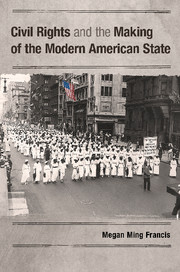Book contents
- Frontmatter
- Dedication
- Contents
- List of Figures and Table
- Illustrations
- Acknowledgments
- Abbreviations
- 1 Rethinking Civil Rights and American Political Development
- 2 The Birth of the NAACP, Mob Violence, and the Challenge of Public Opinion
- 3 The Unsteady March into the Oval Office
- 4 Anti-Lynching Legislation and the Sinking of the Republican Ship in Congress
- 5 Defending the Right to Live
- 6 Civil Rights Bound
- Appendix Manuscript Sources
- Bibliography
- Index
- References
5 - Defending the Right to Live
Published online by Cambridge University Press: 05 June 2014
- Frontmatter
- Dedication
- Contents
- List of Figures and Table
- Illustrations
- Acknowledgments
- Abbreviations
- 1 Rethinking Civil Rights and American Political Development
- 2 The Birth of the NAACP, Mob Violence, and the Challenge of Public Opinion
- 3 The Unsteady March into the Oval Office
- 4 Anti-Lynching Legislation and the Sinking of the Republican Ship in Congress
- 5 Defending the Right to Live
- 6 Civil Rights Bound
- Appendix Manuscript Sources
- Bibliography
- Index
- References
Summary
The states are indifferent or helpless, so that federal action is necessary to protect the citizenship rights of individuals and to maintain law and order in the case of Negroes accused either of crimes or infractions of what would be regarded by white people as improper actions.
– NAACP Anti-Lynching Committee, November 14, 1919The year 1923 is not usually considered to be part of the civil rights movement timeline. It is not etched into our collective memory, like the landmark Brown v. Board of Education Supreme Court decision of 1954, the courage of the Little Rock Nine in 1957, or the March on Washington in 1963. But if the U.S. civil rights movement is understood as an effort to secure the full social, political, and legal rights of citizenship, then 1923 marks a significant event. That year, the NAACP fundamentally changed the operation of Jim Crow courtrooms in the South when the Supreme Court of the United States directly responded to the NAACP’s appeal and handed down a landmark decision in Moore v. Dempsey, 261 U.S. 86, which reversed the death sentences of six African American men in Phillips County, Arkansas, on the grounds that these defendants had their Fourteenth Amendment rights violated by a hostile white mob. As one of the NAACP’s leaders would write afterward, “The Supreme Court decision in this notable case thus becomes one of the milestones in the Negro’s fight for justice – an achievement that is as important as any event since the signing of the Emancipation Proclamation.”
For many, Moore v. Dempsey was shocking – mob-dominated trials and hastily issued death sentences for African American defendants had been widely accepted practices in the South ever since the legal end of slavery. In this context, state criminal trials were typically considered to be immune from federal court oversight. Thus, Moore v. Dempsey marked a turning point in legal discourse about constitutional rights, due to the Supreme Court’s willingness to intervene in unjust state criminal court proceedings. Even more remarkable, the U.S. Supreme Court would continue to narrow the power of individual states in the area of criminal law and broaden federal court power through a string of groundbreaking criminal procedure decisions in the following decades.
- Type
- Chapter
- Information
- Civil Rights and the Making of the Modern American State , pp. 127 - 163Publisher: Cambridge University PressPrint publication year: 2014



